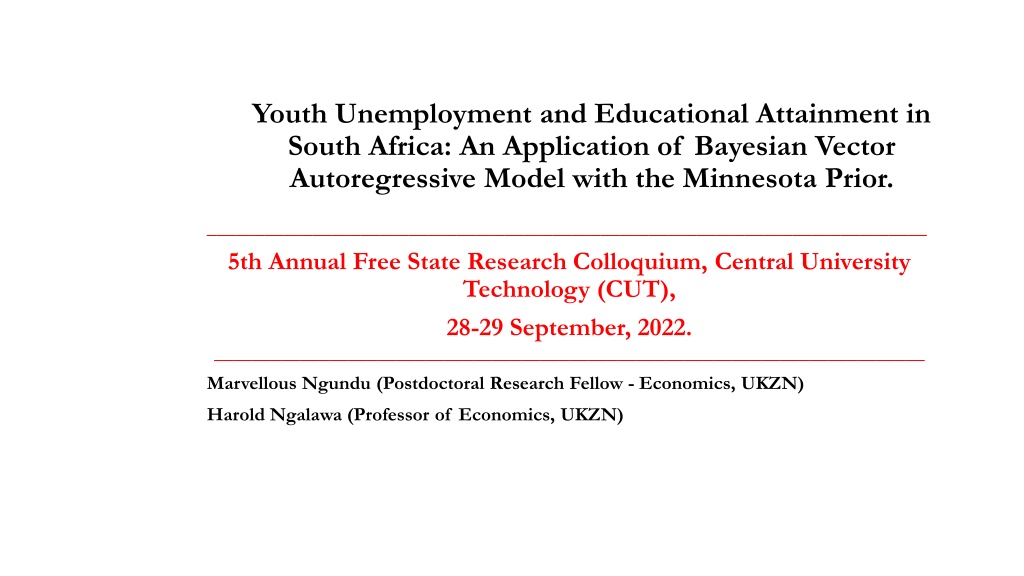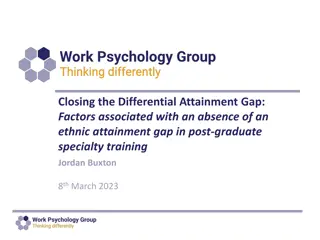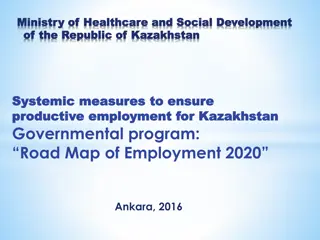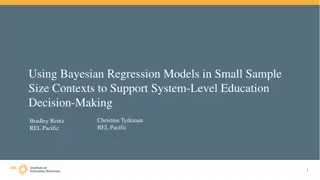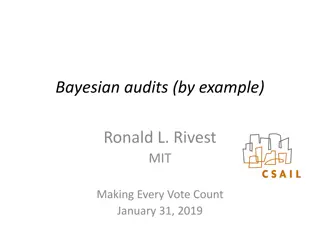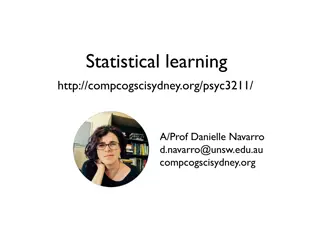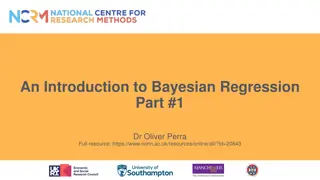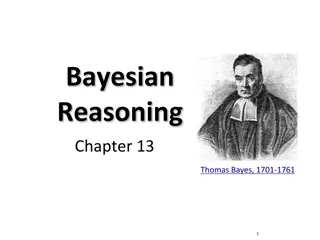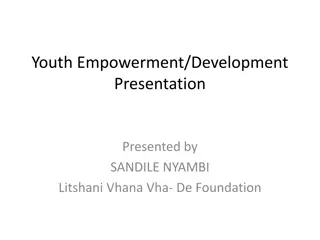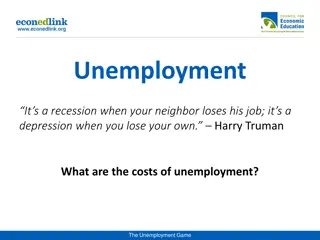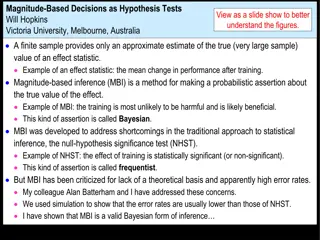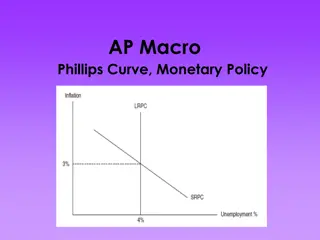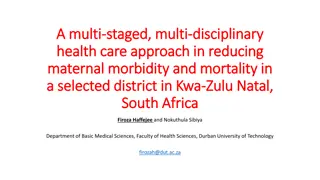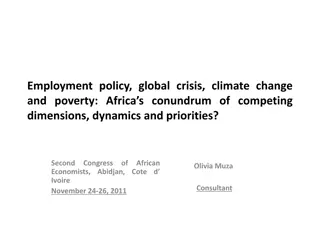Youth Unemployment and Educational Attainment in South Africa: A Bayesian Study
Youth unemployment in South Africa remains high, particularly among lower-aged individuals, despite an increase in educational attainment. Various studies have shown the positive impact of tertiary education on reducing unemployment risks. However, the mismatch between supply and demand for tertiary-educated youth in the labor market raises questions. This research delves into the relationship between educational attainment and youth unemployment, emphasizing the importance of quality tertiary education.
Download Presentation

Please find below an Image/Link to download the presentation.
The content on the website is provided AS IS for your information and personal use only. It may not be sold, licensed, or shared on other websites without obtaining consent from the author. Download presentation by click this link. If you encounter any issues during the download, it is possible that the publisher has removed the file from their server.
E N D
Presentation Transcript
Youth Unemployment and Educational Attainment in South Africa: An Application of Bayesian Vector Autoregressive Model with the Minnesota Prior. ___________________________________________________________________________ 5th Annual Free State Research Colloquium, Central University Technology (CUT), 28-29 September, 2022. __________________________________________________________________________ Marvellous Ngundu (Postdoctoral Research Fellow - Economics, UKZN) Harold Ngalawa (Professor of Economics, UKZN)
OUTLINE Introduction Educational attainment status of the South Africa's working-age population What data can tell Objective of the study Theoretical underpinning Empirical Strategy Findings Conclusion and Recommendations
INTRODUCTION Youth unemployment has been persistently high, with lower youths (15 to 24 years) being the most vulnerable in the labour market (Stats SA, 2021): South Africa s Quarterly Labour Force Survey (QLFS) statistics show that upper (25 to 34 years) and lower youth unemployment rates were 52.8% and 75.1% in the first quarter of 2022 (Q1: 2022), respectively, 19.2% and 18.7% higher than in Q1: 2008. Surprisingly, this youth unemployment crisis is observed during the period when educational attainment is on the rise. Yet, Empirics indicate that: 1. Using the probit regression model, Dias and Posel (2007) found that tertiary education hedged against unemployment risk in South Africa from 1995 to 2003, and the payoff benefits increased over time. 2. Likewise, van Broekhuizen (2016) separated graduates (degree holders or NQF level 7 and above) from other tertiary education qualifications to analyze graduate unemployment in South Africa using the probit model for the period (2000-2013) and found that graduates are the only group with the best labour market prospects relative to other education cohorts. The study emphasized the importance of tertiary education quality and level in the unemployment-tertiary education attainment nexus. 3. Mpendulo and Mang unyi (2018) found a significant positive relationship between education level and youth unemployment in selected rural district municipalities in the Eastern Cape province of South Africa. However, Mpendulo and Mang unyi s findings can hardly be generalized due to sampling bias. 4. According to Horner, Zhang, and Furlong (2018), adequate government funding for tertiary education can significantly reduce unemployment. Thus, a natural issue to peruse is whether the supply of youths with tertiary education qualifications in the labour market is increasing faster than demand, or whether youths are reluctant to pursue tertiary education, resulting in an accumulation of youths without higher education qualifications in the labour market.
EDUCATIONAL ATTAINMENT STATUS OF THE SOUTH AFRICAS WORKING POPULATION A look at OECD education statistics shows that South Africa s educational attainment is skewed towards upper secondary education (OECD, 2019). In 2018, more than half (59%) of South Africa s working-age population had upper secondary qualifications as their highest educational attainment, relative to 7% with tertiary education qualifications. Upper youths with upper secondary education made up 77% of the working-age population, while tertiary education graduates made up only 6%. These statistics indicate that tertiary education attainment is not prevalent in South Africa. Young South Africans with upper secondary education are over twice as likely to be neither in employment nor in education or training (NEET) than those with a tertiary education. (OECD, 2019: 2). In terms of funding, tertiary education in South Africa receives less government funding than basic education. In the 2019/2020 budget, for instance, only 1.1% (Trading Economics, 2022) of the total (6.2%) (Trading Economics, 2022a) government funding share of Gross Domestic Product (GDP) on education was allocated to tertiary education, and the rest was allocated to basic education.
WHAT DATA CAN TELL 100 90 80 70 Unemployed Tertiary Education Attainment, % of Upper Youth Labour Force 60 Unemployed Tertiary Education Attainment, % of Lower Youth Labour Force 50 Unemployed Secondary Education Attainment, % of Upper Youth Labour Force 40 Unemployed Secondary Education Attainment, % of Lower Youth Labour Force 30 20 10 0 Figure 1: South Africa s unemployed population with Secondary and Tertiary Education qualifications, as a ratio of youth group labour force for the period (Q1:2008-Q1:2022). Source: Authors estimations using QLFS data (QUANTEC, 2022).
OBJECTIVE OF THE STUDY Based on the information provided in the previous slides, it is reasonable to suggest hypothetically that South Africa s youth unemployment is prevalent among youth population with at most secondary education as their highest qualification. Thus, the purpose of this study is to investigate how youth unemployment responds to secondary and tertiary education attainment shocks over time. The study also aims to forecast youth unemployment in South Africa to inform progress of the National Development Plan (NDP) s goal of reducing unemployment to less than 6% by 2030. In South Africa, the youth age group ranges from 15 to 34 years, with lower youth (15 to 24 years) and upper youth (25 to 34 years) (Stats SA, 2021). The study focuses on the lower and upper unemployed youth populations separately.
THEORECTICAL UNDERPINING The relationship between youth unemployment and educational attainment in this study is theoretically centred on the human capital theory. According to the human capital theory, formal education is a vital factor in labour s marginal productivity and earnings. Productivity expected from the labour force is often linked to educational attainment; the higher the level of educational attainment, the more productive an individual is perceived to be. This follows that highly educated individuals are more competitive in the labour market and, as a result, more employable due to their perceived productivity.
EMPIRICAL STRATEGY Data on educational attainment in South Africa is scarce, with only data for secondary and tertiary education, among other educational qualifications, available from Q1: 2008 to Q1: 2022. To account for this short time dimension, the study uses a Bayesian Vector Autoregressive (VAR) model with a Minnesota prior to simulate youth unemployment as a function of secondary and tertiary education attainment (% of the labour force for a specific youth age group), while controlling for inflation. The Bayesian VAR model with the Minnesota prior is effective for modelling and forecasting long-run relationships among short non-stationary macroeconomic time series (see, for example, Lopreite & Zhu, 2020; Ma, Shang & Zhang, 2021). QUANTEC provides data on educational attainment in totals of the employed, unemployed, and economically inactive population. To meet the study's objective, we converted total secondary and tertiary education attainment for the economically active population to percentages of the labour force for each youth age group. Inflation is measured as the consumer price index (CPI) of all items.
BAYESIAN VAR MODEL WITH A MINNESOTA PRIOR The mathematical form of the Bayesian VAR model is derived based on unrestricted frequentist VAR(p) as shown in Equation (1) below. ? ??? 1+ ??, with ??= ?~(0, ) (1) ??= ? + ?=1 The Bayesian approach allows researchers to combine sample data with prior knowledge of VAR coefficients (priors) to estimate the posterior distribution using the maximum likelihood function. The Minnesota prior shrinks the estimates of Equation (1) towards a multivariate random walk model using the mean and covariance matrix moments outlined below (Kotz , 2013): ?? ? = ?, ?2 (2) ??,? 2 ??? ?? ? ?. ??? The prior shrinkage parameter ( ) controls the overall prior variance of all coefficients in Equation (1), whereas controls the tightness of the variances of the coefficients of lagged variables other than the dependent variable in each specification. The structural responses are obtained by imposing a recursive structure on the impact multiplier matrix, with the models specified and variables ordered as follows: (3) ??= ????,???_???,????? (4) ??= ????,???_???,????? (5) ??= ????,???_???,????? (6) ??= ????,???_???,????? Inflation is ordered last in all specifications, so the shock to the inflation equation can be interpreted as a monetary policy shock without a contemporaneous effect on youth unemployment and educational attainment.
DESCRIPTIVE STATISTICS Figure 2: Descriptive statistics Source: Authors computation using gtsplot in BRM package, RStudio. These statistics indicate that secondary education attainment has been higher than tertiary education attainment across all youth age groups. Furthermore, comparing the two age groups in terms of unemployment and education attainment reveals that lower youths are more vulnerable in the labour market, despite having relatively high education attainment (both secondary and tertiary).
MAIN FINDINGS: 1) Response of upper-age youth unemployment to secondary education attainment The shaded areas represent the posterior coverage intervals for 95% of the Bayesian credible sets obtained through Gibbs sampling with 10000 iterations. For each specification, the IRFs are presented for up to 40 periods (10 years). The forecasts range from Q1: 2022 to Q4: 2025. Figure 3: Bayesian VAR IRFs and Forecasts of upper youth unemployment (UYU), secondary education attainment as a percentage of the upper youth labour force (Sec_UY), and inflation (infl). Source: Authors computation using Rstudio
MAIN FINDINGS: 2) Response of lower-age youth unemployment to secondary education attainment. Figure 4: Bayesian VAR IRFs and Forecasts of lower youth unemployment (LYU), secondary education attainment as a percentage of the lower youth labour force (Sec_LY), and inflation (infl). Source: Authors computation using RStudio
MAIN FINDINGS: 3) The response of upper-age youth unemployment to tertiary education attainment. Figure 5: Bayesian VAR IRFs and Forecasts of upper youth unemployment (LYU), tertiary education attainment as a percentage of the lower youth labour force (Ter_UY), and inflation (infl). Source: Authors computation using RStudio
MAIN FINDINGS: 4) The response of lower-age youth unemployment to tertiary education attainment. Figure 6: Bayesian VAR IRFs and Forecasts of lower youth unemployment (LYU), tertiary education attainment as a percentage of the lower youth labour force (Ter_LY), and inflation (infl). Source: Authors computation using RStudio
THE RESPONSE OF YOUTH UNEMPLOYMENT TO INFLATION SHOCK Figures 3 6 show that the response of youth unemployment (both lower and upper) to an inflation shock is consistent across all specifications (third row, first column). An inflation shock sharply reduces youth unemployment by approximately 0.3% in the first period. After period 1, the unemployment rate gradually rises. However, the negative impact on youth unemployment is evident beyond the 12th period for upper youth unemployment (Figure 3) and the 7th period for lower youth unemployment (Figure 4) in the case of secondary education attainment, and the 10th (Figure 5) and the 8th (Figure 6) in tertiary education attainment, respectively. If these results are read along with the inflation series, we can derive that the decisive impact of inflation (expansionary monetary policy) on youth unemployment is transitory and subject to an inflation threshold rate of 54.4%, assuming no wage puzzle. Inflation above 54.4% can exacerbate youth unemployment, though long-term negative effects are observed above 80%.
FORECASTS This is concerning because inflation forecasts across all specifications (see bottom Forecast graphs across all Figures 3-6) indicate that inflation will continue to rise from 101% in Q1: 2022 to around 150% in Q4: 2025. Similarly, upper and lower youth unemployment rates are expected to rise further, reaching 60% and slightly more than 75%, respectively, in Q4: 2025. (see, top Forecasts graphs across all Figures 3 6). Although secondary education attainment among upper youth is expected to fall slightly to around 95% in Q3: 2022, the trend shows that it will rise back to 97.1% in Q4: 2025 (see, middle Forecast graph of Figure 3). As a result, secondary educational attainment among upper youths is unlikely to change significantly until Q4: 2025, whereas tertiary education among the same age group is expected to rise to 50% (see, middle Forecast graph of Figure 5), 4.5% higher than in Q1: 2022. Secondary and tertiary education attainment among the lower youth labour force is expected to rise further, reaching 250% (see middle Forecast graph of Figure 4) and 125% (see middle Forecast graph of Figure 6) in Q1: 2025, respectively.
SUMMARY OF FINDINGS, CONCLUSION, AND RECOMMENDATIONS We find that the deleterious impact of tertiary education attainment shock on upper youth unemployment is transitory (2.5 years) and less severe. After 2.5 years tertiary education attainment significantly reduces upper youth unemployment. Secondary education attainment shock raises both lower and upper youth unemployment in the short and long run, with a severe impact on the lower youth labour force. We also find that persistent youth unemployment discourages young South Africans from pursuing both secondary and tertiary education; hence, youth unemployment in South Africa is primarily composed of young school leavers. Another intriguing finding is that the decisive impact of inflation shock on youth is transient and subject to a 54.4% threshold. Beyond this threshold, inflation exacerbates youth unemployment and the impact is severe. According to our findings, it seems that South Africa s labour market still allows the youth labour force to hedge against unemployment risk through tertiary education attainment, with highly educated graduates having the best labour market prospects. In terms of policy recommendations, support for formal tertiary education in terms of funding, relevance, and quality is necessary to curb youth unemployment.
